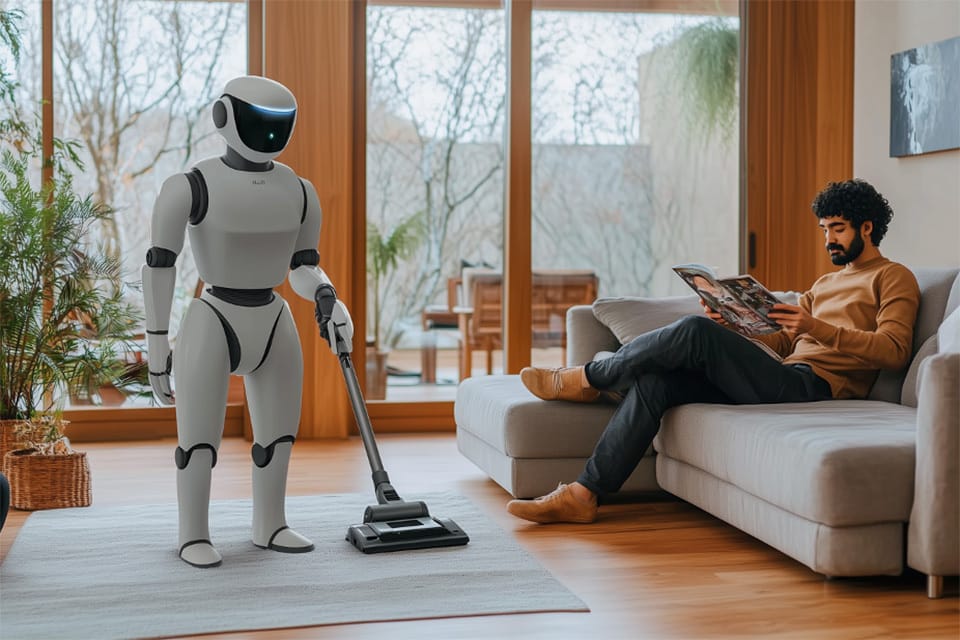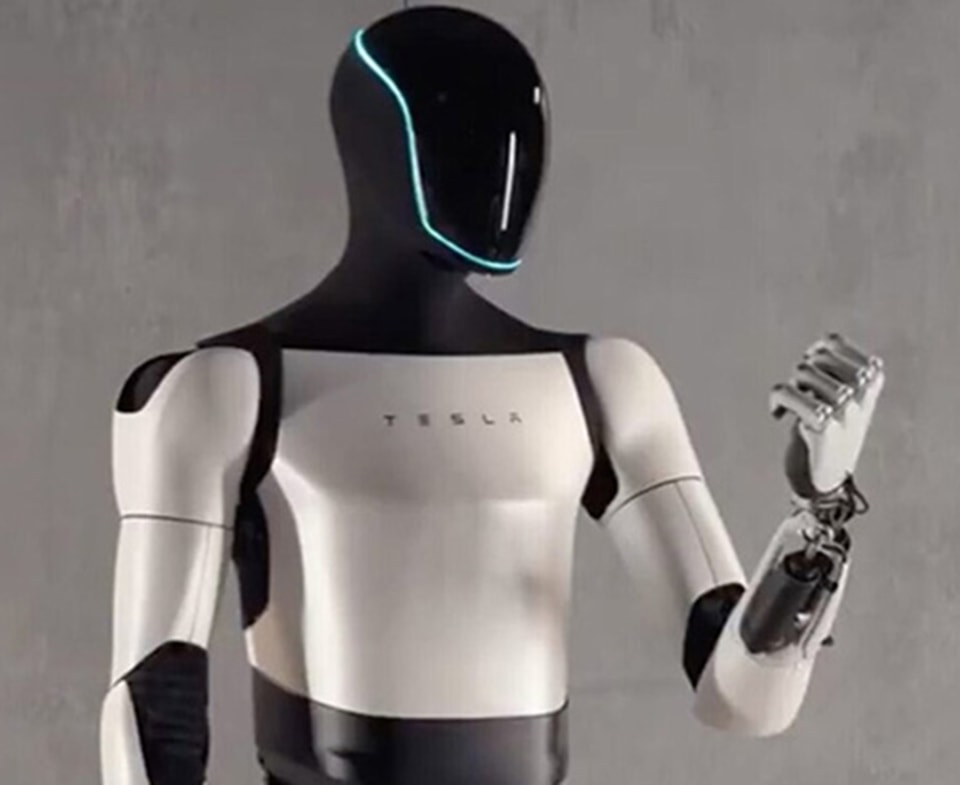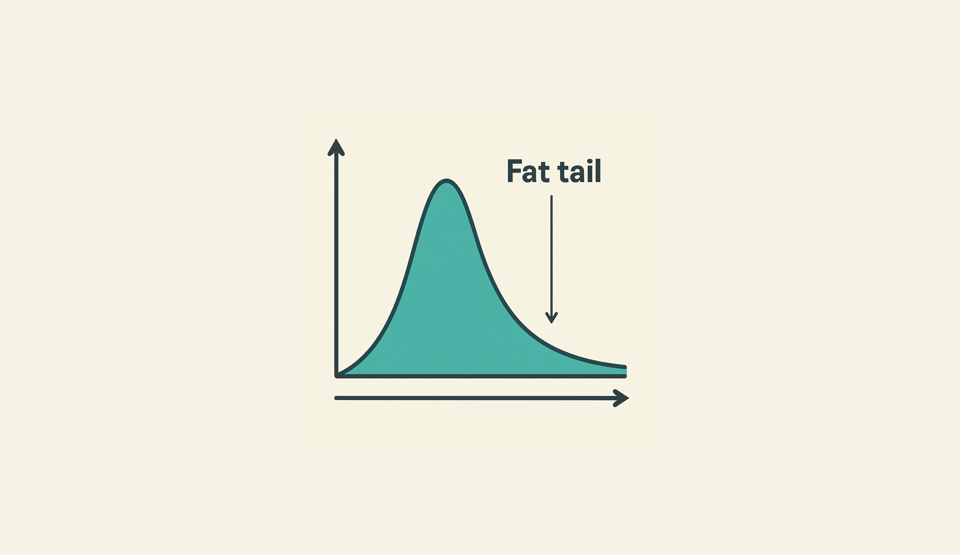Memo Published May 8, 2025 · 12 minute read
Are Robots the New Chatbots?
Mike Sexton

Takeaways
- Recent AI breakthroughs have been built upon large language models, but these systems only have factual intelligence (what some call “internet AI.”)
- Robots will require self-awareness, spatial reasoning, physical dexterity, and more skills to successfully impact our lives—a subfield of AI known as “embodied AI.”
- Embodied AI is considered by some to be a prerequisite component of the theoretical ideal of artificial general intelligence (AGI).1
- While robotics and embodied AI are developing more gradually than chatbots, recent investments and innovations in the field are considerable.
- Humanoid robots can reduce the amount of menial labor necessary across the economy, advancing a paradigm that shifts the burden of “work” from labor to management.
Robots are Coming
AI has been steadily rippling through the economy since ChatGPT’s 2022 premiere. While “automation” has historically been associated with physical labor, contemporary AI has been transforming intellectual labor most of all. AI reasoning models and deep research capabilities have made chatbots the ultimate research assistants, and Y Combinator CEO Gary Tan says startups today are being launched with 95% of their code written by AI.2

While slower than the chatbot revolution, AI and robotics are developing apace too. Amazon already utilizes more than 750,000 robots in its warehouses, from flat, wheeled robots that lift and transport shelves to robotic arms that sort products.3 Cyberspace-native Meta and Google are investing substantial resources in humanoid robotics.4 Tesla has built prototypes of a humanoid robot called Optimus, which Elon Musk promises will be able to play piano and thread needles.5 Although Apple’s efforts to incorporate generative AI into iPhones have been widely characterized as “flat-footed,” the company has developed a prototype of an expressive robotic desk lamp reminiscent of the Pixar lamp that has enchanted many of the company’s fans.6
Some of the most compelling advances in robotics come not from big tech mainstays but narrowly focused small- and medium-sized businesses. The humanoid robots in Amazon’s warehouses aren’t built in-house but by Agility Robotics, a company spun out of the robotics program at Oregon State University.7 Boston Dynamics now builds humanoid robots that can breakdance and do cartwheels.8 If you’re looking for a maid, 1x Technologies is testing Neo Gamma, a humanoid robot with a soft knit exterior that is designed to help with household chores.9
These innovations are a distinct subfield of AI known as embodied AI, where AI technology learns from its environment rather than a static set of training data.10 Embodied AI encompasses not only AI-powered robots but also self-driving cars and autonomous weapons. The future of embodied AI will be highly agentic: consumer robots (embodied AI agents) will not only be aware of their surroundings but be able to anticipate environmental changes (weather, pet messes, a full hamper) and act independently to serve their owners.
What’s Changed?
Several breakthroughs in research, software, and chips have made today’s underrecognized robot race possible. The latest robots feature vision language models (VLMs), programs that combine large language models (like ChatGPT and its competitors) with a vision encoder that enables the program to “see” and process both verbal and visual information.11 When AI can process multiple formats of information like this, it is referred to as multimodal.
Computer vision—machines’ ability to interpret and understand visual information—has been improving for years before ChatGPT. In 2009, Fei-Fei Li built ImageNet, the first large-scale dataset of images for training AIs in visual recognition.12 In 2012, ImageNet led to AlexNet, a high-performing AI capable of recognizing images, which OpenAI cofounder Ilya Sutskever and Nobel Prize winner Geoffrey Hinton trained on Fei-Fei Li’s image dataset. More recently, Meta has open-sourced the Segment Anything Model (SAM), an AI that can take any image or video and segment out objects dynamically.13
Computer vision, like embodied AI, encompasses more than robots. Meta’s AI-enabled Ray-Ban sunglasses use computer vision to identify objects and landmarks in the wearer’s field of view.14 Waymo, the Google-owned self-driving car company whose driverless taxis operate in Metro Phoenix, the Bay Area, and Los Angeles, (and possibly soon in Washington, DC), is made possible through advances in computer vision.15 AI medical imaging also shows noteworthy promise by using computer vision to assist in diagnostics.
But visual processing is only part of the puzzle. A robot must also “learn” how to operate its limbs to navigate the world around it through a process known as reinforcement learning. In recent years, this has been accelerated with a new Matrix-like innovation called digital twin technology. Developers today build virtual representations of a robot within a computer program and train it in virtual environments with accurately simulated physics, dramatically speeding up the learning process.
Nvidia has released an application for this purpose known as Isaac Sim.16 Isaac Sim is just one application for Nvidia’s digital twin platform Omniverse—a physics simulator of staggering complexity. Omniverse allows for the simulation of entire industrial manufacturing facilities and is employed by companies like GM, Hyundai, and Mercedes-Benz to identify and implement new optimizations.17 Nvidia has even built Earth 2, a virtual twin of the earth in Omniverse for ultra high-fidelity weather forecasting.18
Where are We Going?
Frontier AI models are routinely surpassing benchmarks (a process known as “saturation”), and robots are becoming more advanced every week. Related fields like computer vision and digital twin technology feed into innovations in industrial manufacturing and self-driving cars, which in turn will unlock more ways to make AI and robots useful to us.19 This innovation feedback loop resembles the intelligence explosion that AI theorists hypothesize will occur when humanity reaches the technological singularity.20 But at what point can we expect useful consumer robots to arrive?
British mathematician I. J. Good said that once an AI is built that “surpass[es] all the intellectual activities of any man however clever,” then that AI will be able to build an even better AI than itself, which in turn will build still better AIs in a process known as recursive self-improvement. The point where AI can recursively self-improve without human intervention is known as the singularity or takeoff.21 The AI’s actions then take on a moral character, ranging from messianic to apocalyptic.
Sociologist Zeynep Tufekci (too-FEK-chee) thinks it is a mistake to imbue technology like AI with morality. Having grown up in Turkey, she remembers clearly how the utopian dreams of social media turned to nightmares as the Arab Spring resulted in more civil wars than stable democracies.22 In her view, technology is neither good nor evil, but humans do good or evil with it.23 Tufekci notes social media AI algorithms have been able to detect the onset of manic episodes in people with bipolar disorder for longer than ChatGPT has been around. AI doesn’t offer them Las Vegas flight and hotel package deals, but a company might.
We can broaden Tufekci’s principle to critique singularity theory: AI does not build AI, humans using AI build AI. GPT-4 is a large language model with broad knowledge and quick responses. OpenAI employees used GPT-4 to build o1, a slower reasoning model with superior logic, math, and coding skills. DeepSeek employees used (and distilled) American AI models to build R1, a reasoning model like o1 but with much higher energy efficiency.24 Now developers of agentic AI and robotics are using and incorporating these technologies to build still more powerful systems.
In theory, we have not reached the singularity because artificial general intelligence (AGI)—an AI exceeding the intellect of every human—does not exist. Some argue that embodied AI is a necessary component of AGI, meaning the singularity will not arrive until robots match human spatial understanding and motor skills.25 So perhaps the singularity will arrive once humanoid robots are superior to humans at every intellectual and physical task imaginable. Or perhaps, for all intents and purposes, the intelligence explosion is underway and we passed the event horizon years ago.
Cool the Hype
Robots can currently perform a surprising amount of repetitive human tasks, including basic cleaning (1x Technologies), putting away groceries (Figure AI), and even cooking (Moley Robotics).26 People have built robotic arms that can thread needles, play piano, and even crack eggs.
Today’s humanoid robots are still quite short of human-level embodied intelligence—they walk slowly and awkwardly—but they are improving. AI expert Ethan Mollick likes to point out “today’s AI is the worst you will ever use,” and this principle can be extended to robots.27 But we could say the same thing about self-driving cars, so why should we assume robots will not be the same—always “five years away”28 from maturity?

It is easy to train a self-driving car to navigate safely under normal circumstances, but mathematically, the situations and conditions that challenge self-driving systems (erratic drivers, extreme weather) are not that uncommon over the lifetime of a car. Humanoid robots are also practically guaranteed to encounter unusual circumstances when deployed that their training has not prepared them for. These unlikely yet statistically significant scenarios are known as “fat tails,” a common concept in statistics and finance.29
However, humanoid robots do not weigh thousands of pounds or travel more than a couple miles per hour. If a robot encounters an unusual but not impossible situation, like a precariously placed set of fine china or two people choking simultaneously, it does not contribute risk in the same way as a moving vehicle (assuming the robot is not misaligned). If the robots’ AI can navigate such situations successfully—or at least not detrimentally—we should expect the robots to eventually diffuse into the workforce.
What’s Happening to Work?
The emergence of an abundant humanoid robotic workforce is both an unprecedented societal opportunity and a dark cloud hanging over the working class. If robots can perform manual labor more cheaply than humans, will jobs disappear, or will robots and humans work together, potentially creating even more jobs?
We may be able to infer some details about the future by looking at modern militaries, where soldiers today operate a diverse array of lethal autonomous weapons. These weapons, including turret guns, drones, and air defense systems, have far better aim and reflexes than humans, enhancing warfighters’ effectiveness dramatically. In today’s military, humans work with such systems in highly optimized processes to achieve objectives at a pace that would have stunned previous generations.
Of course, human oversight in the military is key. Lethal autonomous weapons are virtually all designed to involve some human-in-the-loop who can authorize a strike (e.g., for a drone) or override one (e.g., for an air defense system). Activists and militaries alike understand that accountability cannot be automated—a principle that can help us think critically about what the nature of work will be in 10 years.
The human-in-the-loop paradigm is becoming increasingly important as AI becomes more agentic—a trend that includes AI-enabled robots completing physical tasks. As businesses lean more on AI to automate processes and increase productivity, human employees’ time and attention are being increasingly characterized as luxury goods. Assuming an employer has a variety of powerful AI agents and robots to delegate work to, the logical places to put human employees are in front-of-house and supervisory roles.
With humans in the loop, work is also expected to change. Khanmigo is a ChatGPT-powered AI tutor that has been piloted in hundreds of middle and high schools, showing how teachers’ work may be redefined soon.30 Khanmigo can give personalized answers to students’ questions and grade students’ homework and exams—including essays. By taking on these burdens, Khanmigo leaves teachers with more bandwidth for human-centric and strategic work: classroom management, student mentorship, and interaction with parents.
It is intuitive to assume that as AI and robots perform more human work, less work will be left for humans to do. However, assuming there is a fixed limit to the work available in an economy is known as the lump of labor fallacy.31 Rather than eliminating teachers’ roles, Khanmigo shows how AI can augment human jobs, freeing employees to focus on tasks requiring empathy, judgment, and self-reflection. We cannot predict that AI will only augment human labor, but history shows that the last century and a half of advancing technology has ultimately created more jobs than it has eliminated.32
Policymakers and businesses should seize upon this lesson and think critically about how AI, robots, and humans can cooperate to deliver an abundant future. Despite the intuitive lump of labor fallacy, the American economy is in fact plagued by scarcity—in housing, energy, manufacturing, education, law enforcement, transportation, food service and hospitality, health care and pharmaceuticals, and even internet access.33
Polling by the MIT Industrial Performance Center finds that African American, Hispanic, and less formally educated workers are more likely than other demographics to be optimistic about the impact AI will have on their jobs.34 Rather than hand-wringing about the risk of AI and robots displacing yesterday’s jobs, forward-thinking legislators and entrepreneurs should imagine the opportunities for humans and machines to work together to solve these immediate and urgent challenges instead.
Conclusion
Robots are developing quickly. Anyone experiencing post-ChatGPT whiplash would be well advised to brace themselves. Just as the chatbot revolution disrupted big tech incumbents with new entrants like OpenAI, Mistral, and Anthropic, so too are small companies and startups like 1x Technologies, Figure AI, and Boston Dynamics redefining the frontier of robotics today.
As developments in and around AI and robotics compound upon each other, it becomes increasingly urgent to grapple with the theoretical implications of AGI and the singularity. While AGI has historically been regarded as either science fiction or decades from reality, a “near-consensus” of experts today anticipate a system qualifying as AGI before 2030.35
If AGI-equipped robots truly are on the cusp of entering the workforce in droves, it is not a foregone conclusion that they will eliminate human jobs en masse. If we approach this moment opportunistically rather than anxiously, government and businesses can work together to not only create jobs but good lives for all Americans.
Note: The banner image in this memo was generated with Midjourney; the ‘fat tail’ illustration was generated with ChatGPT 4o.
